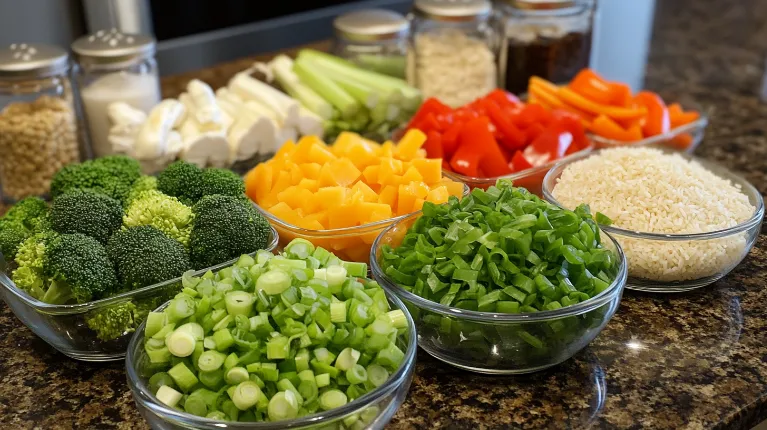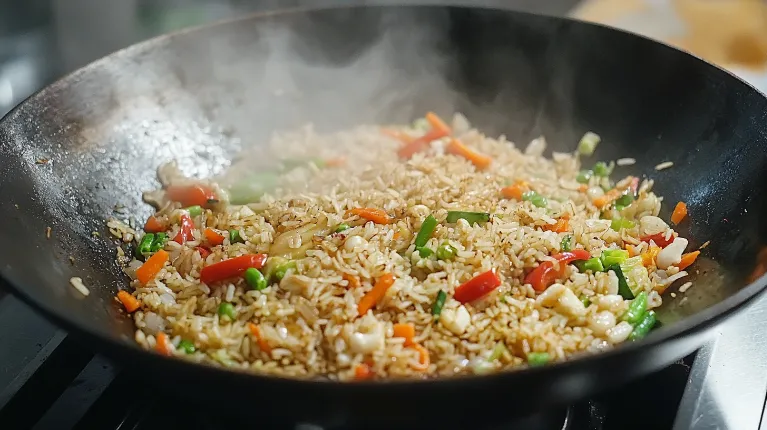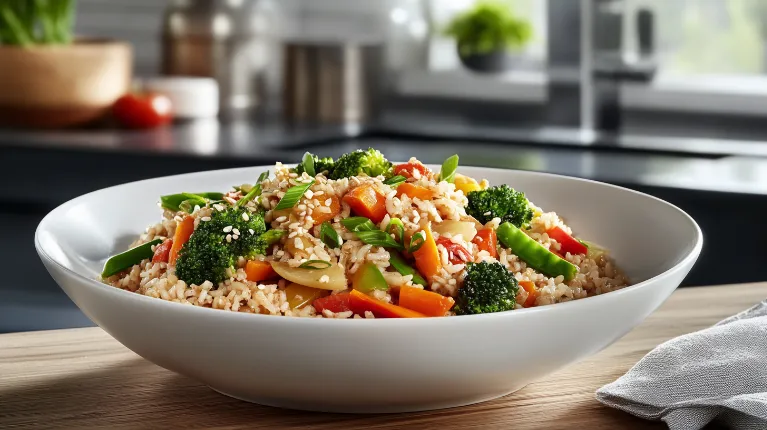Brown rice with vegetables may sound simple, but when infused with the vibrant, aromatic flavors of Southeast Asia, it becomes a true culinary delight. Imagine a dish that’s healthy, colorful, and bursting with bold tastes from garlic, ginger, soy sauce, and sesame oil. This Southeast Asia brown rice with vegetables recipe is perfect for anyone looking for a nutritious meal that doesn’t skimp on flavor.
What makes this recipe unique is its balance of heartiness and freshness. Moreover, it’s incredibly versatile—you can make it vegan, add your favorite protein, or adjust the vegetables to suit your tastes. Whether you’re prepping for the week or whipping up a quick dinner, this dish delivers every time.
Speaking of quick dinners, have you ever wondered why so many people swear by whole grains like brown rice? Well, not only is it healthier than white rice, but it’s also more filling, thanks to its fiber and nutrient-packed layers. For a deeper dive into why brown rice is so amazing, check out this comprehensive guide.
History and Origin
Southeast Asian cuisine is as diverse as its geography, with each country adding its spin to staples like rice and vegetables. Historically, rice has been the backbone of diets in this region, with brown rice gaining popularity in recent years due to its health benefits.
Countries like Thailand, Indonesia, and Vietnam have perfected the art of blending earthy rice with fresh produce, creating dishes that are both comforting and exciting. For instance, Thai fried rice often features bold chili paste, while Indonesian nasi goreng is a smoky, umami-packed delight.
Fun fact: In many Southeast Asian cultures, rice isn’t just a food—it’s a way of life. It’s celebrated during harvest festivals and even has its place in traditional stories and songs. Honestly, it’s not surprising that these cuisines have elevated a humble grain into something magical.
Additionally, vegetables play a starring role in this recipe, reflecting the region’s emphasis on using seasonal, farm-fresh ingredients. From crunchy snap peas to sweet carrots, each veggie brings its texture and flavor to the mix.
Ingredients and Equipment for Southeast Asia Brown Rice with Vegetables Recipe
Ingredients
| Ingredient | Quantity | Substitution Suggestions |
|---|---|---|
| Brown rice | 1 cup | Jasmine or basmati rice for a fragrant alternative |
| Mixed vegetables | 2 cups | Use any combination like broccoli, carrots, bell peppers, or snap peas |
| Garlic | 3 cloves (minced) | Garlic powder (1 tsp) if fresh isn’t available |
| Ginger | 1-inch piece | Ground ginger (1/2 tsp) as a substitute |
| Soy sauce | 2 tablespoons | Tamari for a gluten-free option |
| Sesame oil | 1 teaspoon | Olive oil for a milder flavor |
| Salt and pepper | To taste | Adjust according to preference |
| Green onions (optional) | 2 stalks (sliced) | Chives or parsley as alternatives |
| Sesame seeds (optional) | 1 teaspoon | Toasted sunflower seeds for crunch |
Equipment
- Large pot (for cooking rice)
- Wok or large skillet (for stir-frying vegetables)
- Cutting board and knife
- Measuring cups and spoons
- Wooden spoon or spatula

How to Make the Perfect Southeast Asia Brown Rice with Vegetables Recipe
Step-by-Step Guide to Cooking the Recipe
Creating this Southeast Asia brown rice with vegetables recipe is easier than you think! With simple steps and a few pro tips, you’ll have a dish that’s packed with bold flavors and wholesome ingredients. Let’s dive right into it.
Step 1: Prepare the Brown Rice
First, rinse 1 cup of brown rice thoroughly under cold water. This helps remove excess starch and prevents the rice from becoming sticky.
Next, in a large pot, combine the rinsed rice with 2 cups of water and a pinch of salt. Bring the mixture to a boil over medium-high heat. Once it starts boiling, reduce the heat to low, cover the pot, and let it simmer for about 30-35 minutes until the rice is tender and the water is absorbed.
When the rice is done, remove it from the heat but keep the lid on for 5 minutes. This resting time allows the rice to fluff up perfectly. Fluff it gently with a fork before setting it aside.
Pro Tip: Cooking rice in advance can save time and make the texture even better for stir-frying. If you have leftover rice, this is the perfect way to use it up!
Step 2: Prep the Vegetables
While the rice is cooking, prep your vegetables. Chop your selection of mixed vegetables into bite-sized pieces. Popular choices include broccoli, carrots, bell peppers, and snap peas.
Next, mince 3 cloves of garlic and grate a 1-inch piece of ginger. These aromatics are essential for infusing the dish with authentic Southeast Asian flavors.
If you’re including optional garnishes like green onions or sesame seeds, slice the onions and toast the seeds lightly in a dry pan for added crunch.
Tip: Try to keep your vegetables uniform in size so they cook evenly.
Step 3: Heat Up the Pan
Then, heat 2 tablespoons of vegetable oil in a large skillet or wok over medium-high heat. A wok works best because it distributes heat evenly and cooks food quickly.
When the oil is hot, add the minced garlic and grated ginger. Sauté them for about 30 seconds, stirring constantly, until fragrant. Be careful not to burn them, as this can make the dish bitter.
Step 4: Stir-Fry the Vegetables
Next, add the chopped vegetables to the skillet. Stir-fry them for 4-5 minutes, or until they’re tender-crisp. Start with harder vegetables like carrots and broccoli, and then add softer ones like bell peppers and snap peas.
Pro Tip: Don’t overcrowd the pan. If your skillet is small, stir-fry the vegetables in batches to maintain their texture and avoid steaming them.
Step 5: Combine Rice and Vegetables
Once the vegetables are cooked, add the prepared brown rice to the skillet. Stir gently to combine everything. Then, pour in 2 tablespoons of soy sauce and 1 teaspoon of sesame oil. Toss the mixture well, making sure the rice and vegetables are evenly coated.
At this stage, taste the dish and adjust the seasoning. You can add a pinch of salt, a dash of black pepper, or a splash of soy sauce to suit your preference.
Optional: For a touch of heat, sprinkle in some red chili flakes or drizzle with sriracha sauce.
Step 6: Garnish and Serve
Finally, transfer your Southeast Asia brown rice with vegetables recipe to a serving bowl or platter. Garnish with sliced green onions and toasted sesame seeds for a pop of flavor and texture.
Additional Tips for Success
- Texture Perfection: Using day-old rice makes it less sticky and ideal for stir-frying. If you’re using freshly cooked rice, spread it out on a baking sheet and let it cool to room temperature before adding it to the skillet.
- Protein Options: Add cooked tofu, shrimp, or chicken to make this dish more filling. Stir-fry these separately before mixing them into the rice and vegetables.
- Spice It Up: Southeast Asian recipes often have a spicy kick. Adjust the heat level with fresh chilies, chili paste, or your favorite hot sauce.
With these steps, you’ll master the art of creating a delicious and healthy Southeast Asia brown rice with vegetables recipe. Ready to learn more about serving and storage? Let me know when you’d like to continue!

Tips for Perfecting the Southeast Asia Brown Rice with Vegetables Recipe
Creating the perfect Southeast Asia brown rice with vegetables recipe can feel effortless when you follow a few simple tips. Let’s troubleshoot common challenges and learn how to get the best results every time.
Avoid Overcooked Rice
Rice texture can make or break this dish. To ensure the rice doesn’t get mushy, cook it to an al dente texture. If you accidentally overcook the rice, spread it out on a baking sheet and allow it to cool. This step reduces moisture and helps retain the desired texture.
Keep Vegetables Crisp
Stir-frying vegetables is all about achieving that perfect crunch. However, if your veggies are soggy, you might be overcrowding the pan. Instead, cook them in smaller batches over medium-high heat. This method ensures even cooking and helps maintain their natural crispness.
Balance Flavors
Sometimes, soy sauce can overpower the dish. On the other hand, too little seasoning can leave the rice bland. To strike the right balance, start with small amounts of soy sauce and sesame oil, then taste and adjust as needed. Adding a squeeze of lime juice at the end can brighten the flavors and elevate the dish.
Customize for Dietary Preferences
If you’re looking to add more protein, tofu, shrimp, or chicken work wonderfully. However, if you’re keeping it vegan, roasted chickpeas or edamame make excellent alternatives.
With these tips, you’ll master this recipe while avoiding common pitfalls, making it a go-to meal for any occasion.
Serving and Garnishing the Southeast Asia Brown Rice with Vegetables Recipe
How you serve and garnish this Southeast Asia brown rice with vegetables recipe can elevate it from simple to spectacular. Here are some creative ideas.
Creative Plating Ideas
Serve the rice in a large, shallow bowl to show off the vibrant mix of vegetables. For an elegant touch, garnish with:
- Toasted sesame seeds for crunch.
- Sliced green onions for freshness.
- Lime wedges for an added zing.
If hosting a dinner party, present individual portions in small bowls or bento boxes for a unique Southeast Asian vibe.
Side Dish Pairings
This dish pairs beautifully with light and flavorful sides. Consider serving it alongside:
- Vegetable spring rolls for a fresh and crispy starter.
- Cucumber salad with rice vinegar dressing to balance the warm, savory rice.
- Miso soup for a comforting addition to your meal.
Pro Tip for Garnishing
Want to enhance the presentation further? Sprinkle chili flakes or drizzle a small amount of chili oil for a subtle heat that complements the dish.
These serving and garnishing ideas add flair and variety to your meal, ensuring your Southeast Asia brown rice with vegetables recipe leaves a lasting impression. Let me know when you’re ready to tackle the final sections!
If you’re looking for a wholesome and flavorful recipe, our Easy Caesar Pasta Salad Recipe is a must-try. It combines the bold, tangy flavors of a classic Caesar salad with hearty pasta, making it perfect for a light lunch or a refreshing dinner side. You can easily customize this salad by adding grilled chicken or chickpeas for extra protein. Pair it with this honey garlic chicken wings recipe for a complete, satisfying meal that’s perfect for any occasion.
Additional Insights for the Southeast Asia Brown Rice with Vegetables Recipe
Healthier Alternatives and Dietary Considerations
The Southeast Asia brown rice with vegetables recipe is already a nutritious dish, but it can be adapted further to meet specific dietary needs. Here are some ideas:
- Low-Carb Option: Replace brown rice with cauliflower rice for a lighter, low-carb variation. Stir-fry the cauliflower rice briefly to maintain its texture.
- Gluten-Free: Use tamari instead of soy sauce to make the dish gluten-free. Additionally, ensure your sesame oil and other seasonings are certified gluten-free.
- Protein Boost: Add plant-based proteins like tofu, tempeh, or roasted chickpeas for a vegan-friendly meal. For meat lovers, grilled chicken or shrimp are excellent choices.
- Extra Veggie Power: Increase the vegetable content by adding leafy greens like spinach or bok choy, which wilt nicely when stir-fried.
These simple swaps not only accommodate dietary preferences but also enhance the nutritional profile of the dish.
Storing, Reheating, and Pairing Beverages
Storing and Reheating Tips
Leftovers of the Southeast Asia brown rice with vegetables recipe store beautifully, making it a great option for meal prep. Follow these tips for best results:
- Storage: Transfer the cooled rice and vegetables into an airtight container. Store in the refrigerator for up to 3 days.
- Freezing: Freeze individual portions in freezer-safe containers for up to 2 months. Label each container with the date for easy tracking.
- Reheating:
- Microwave: Place the rice in a microwave-safe dish, sprinkle with a tablespoon of water, cover loosely, and heat in 1-minute intervals.
- Stovetop: Heat the rice in a skillet over medium heat, adding a splash of water or broth to restore moisture. Stir occasionally to avoid sticking.
Perfect Beverage Pairings
Pairing beverages with the Southeast Asia brown rice with vegetables recipe enhances the dining experience. Here are a few ideas:
- Green Tea: Its earthy flavor complements the nutty rice and savory vegetables.
- Sparkling Water: Add a twist of lime or ginger for a refreshing contrast to the dish’s bold flavors.
- White Wine: A chilled Sauvignon Blanc or Pinot Grigio pairs wonderfully with the light, zesty elements of the recipe.
- Non-Alcoholic Option: A mango or passionfruit mocktail adds a tropical touch to the meal.
For additional tips on meal planning and pairing ideas, check out our Easy and Delicious Blackened Chicken Alfredo Pasta Recipe. It offers insights into crafting balanced meals with thoughtful pairings.
By following these storage, reheating, and pairing suggestions, you’ll enjoy every bite of your Southeast Asia brown rice with vegetables recipe—whether freshly made or as leftovers. Let me know when you’re ready to wrap up the article with FAQs or a conclusion!
Frequently Asked Questions (FAQs) about Southeast Asia Brown Rice with Vegetables Recipe
Is brown rice with vegetables healthy?
Absolutely! The Southeast Asia brown rice with vegetables recipe is a fantastic option for a balanced meal. Brown rice retains its bran and germ layers, making it rich in fiber, vitamins, and minerals. Paired with colorful vegetables, this dish provides antioxidants, essential nutrients, and a variety of textures and flavors. For example, adding broccoli and carrots boosts vitamin C and beta-carotene, supporting overall health. Consequently, this dish is perfect for those looking to eat well without compromising on taste.
What can I add to brown rice to make it taste better?
Brown rice has a naturally nutty flavor, but it pairs wonderfully with bold seasonings. For instance:
- Soy Sauce and Sesame Oil: These staples add savory and nutty notes.
- Aromatics like Garlic and Ginger: They infuse the rice with Southeast Asian-inspired flavors.
- Fresh Herbs: Sprinkle cilantro, parsley, or basil for a burst of freshness.
- Citrus Zest or Juice: Lime or lemon can brighten the dish instantly.
Adding these ingredients to the Southeast Asia brown rice with vegetables recipe ensures a delicious and satisfying meal every time.
What veggies pair well with rice?
The beauty of this recipe lies in its versatility. Vegetables like broccoli, snap peas, carrots, and bell peppers are ideal because they bring crunch, color, and complementary flavors. On the other hand, leafy greens like spinach or bok choy add a soft texture and earthy undertones. For a more robust dish, consider adding mushrooms or zucchini, which soak up the savory seasoning beautifully.
Why do Chinese eat white rice and not brown rice?
Traditionally, white rice has been preferred in many Chinese cuisines because it’s softer, has a milder flavor, and pairs well with bold dishes. Additionally, white rice has a longer shelf life than brown rice, which can go rancid if not stored properly due to its natural oils. However, with the rising focus on health, brown rice is becoming more popular in modern Chinese dishes for its nutritional benefits.
Conclusion
The Southeast Asia brown rice with vegetables recipe is a delightful way to enjoy wholesome ingredients with bold, aromatic flavors. From the nutty richness of brown rice to the crisp, vibrant vegetables, this dish is both nourishing and versatile. Whether you’re cooking for family, meal-prepping for the week, or simply experimenting in the kitchen, this recipe is guaranteed to please.
We encourage you to try this recipe at home and make it your own. Add your favorite vegetables, experiment with proteins, or adjust the spice levels to suit your taste. For more ideas on creating easy, flavorful dishes, check out our Easy Caesar Pasta Salad Recipe.
Finally, don’t forget to share your feedback and creative twists in the comments. We’d love to hear how your Southeast Asia brown rice with vegetables recipe turned out. Happy cooking, and enjoy every bite! Let me know if there’s anything else you’d like to add!




